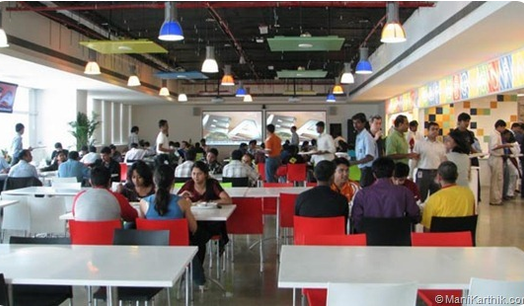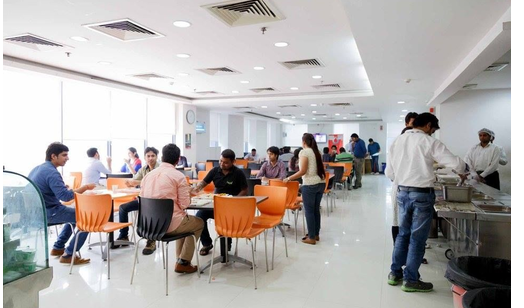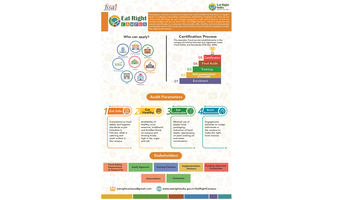CONTEXT
Click here to edit the title
Sources: 1. Chronic Hungry: FAO State of Food Security and Nutrition in the World, 2018 2. Ahirwar & Mondal (2019). Prevalence of obesity in India: A systematic review Diabetes & Metabolic Syndrome, Clinical Research & Reviews Vol, 13:1, 318-321 3. The economics of food safety in India-a rapid assessment by Wageningen Economic Research and ILRI 2017. 4. EAT-Lancet Commission: Brief for Farmers 5. FAO: Food Wastage Footprint & Climate Change
स्रोत: 1. क्रॉनिक हंग्री: एफएओ स्टेट ऑफ फूड सिक्योरिटी एंड न्यूट्रिशन इन द वर्ल्ड, 2018 2. अहिरवार और मंडल (2019)। भारत में मोटापे की व्यापकता: एक व्यवस्थित समीक्षा मधुमेह और मेटाबोलिक सिंड्रोम, नैदानिक अनुसंधान और समीक्षा खंड, 13:1, 318-321 3. इकोनॉमिक्स ऑफ फूड सेफ्टी इन इंडिया-ए रैपिड असेसमेंट बाय वैगनिंगन इकोनॉमिक रिसर्च एंड आईएलआरआई 2017। 4. ईएटी-लांसेट आयोग: किसानों के लिए संक्षिप्त 5. एफएओ: खाद्य अपव्यय पदचिह्न और जलवायु परिवर्तन
BENEFITS OF EAT RIGHT CAMPUS
While the Eat Right Campus initiative is not mandatory to adopt, it can provide immense benefits to the campus and the individuals in the campus not only in terms of health but also economics. Safe, healthy and sustainable food in the campus would reduce the incidence of food borne illnesses, deficiency diseases and non-communicable diseases among the people in the campus. This means less absenteeism and loss of working hours and greater wellbeing, motivation and productivity of people. This would also reduce the burden of healthcare costs for the workplace, institution, hospital, jail or tea estate. All these factors would ultimately result in economic benefits to the campus. In addition, being recognized as an Eat Right Campus would increase the prestige and brand value of the campus, making it attractive for prospective students, employees etc. Last but not the least, this would also inspire other campuses to promote safe, healthy and sustainable food, thus resulting in the overall development of the country. जबकि ईट राइट कैंपस पहल को अपनाना अनिवार्य नहीं है, यह न केवल स्वास्थ्य बल्कि अर्थशास्त्र के मामले में भी परिसर और परिसर में व्यक्तियों को अत्यधिक लाभ प्रदान कर सकता है। परिसर में सुरक्षित, स्वस्थ और टिकाऊ भोजन से परिसर में लोगों के बीच खाद्य जनित बीमारियों, कमी रोगों और गैर-संचारी रोगों की घटनाओं में कमी आएगी। इसका अर्थ है कम अनुपस्थिति और काम के घंटों का नुकसान और लोगों की अधिक भलाई, प्रेरणा और उत्पादकता। इससे कार्यस्थल, संस्थान, अस्पताल, जेल या चाय बागान के लिए स्वास्थ्य देखभाल की लागत का बोझ भी कम होगा। इन सभी कारकों के परिणामस्वरूप अंततः परिसर को आर्थिक लाभ होगा। इसके अलावा, ईट राइट कैंपस के रूप में मान्यता प्राप्त होने से परिसर की प्रतिष्ठा और ब्रांड मूल्य में वृद्धि होगी, जिससे यह संभावित छात्रों, कर्मचारियों आदि के लिए आकर्षक हो जाएगा। अंतिम लेकिन कम से कम, यह अन्य परिसरों को सुरक्षित, स्वस्थ और टिकाऊ को बढ़ावा देने के लिए भी प्रेरित करेगा। भोजन, इस प्रकार देश के समग्र विकास में परिणामी।
EVALUATION CRITERIA
Benchmarks have been created on four different parameters based on which campuses are evaluated and certified as 'Eat Right Campus'. These parameters include food safety measures, steps to ensure provision of healthy and environmentally sustainable food and building awareness among the individuals in the campus to make the right food choices. A detailed checklist has been created based on these parameters, outlining the best practices to be followed by the campus. These practices include mandatory steps such as licensing and registration of food service providers in the campus and compliance to food safety and hygiene standards as per Schedule 4 of the Food Safety and Standards (FSS) Act, 2006. It also includes steps to create an environment of safe, healthy and sustainable eating habits such as promoting local and seasonal food, limiting unhealthy food choices and mass awareness activities. चार अलग-अलग मापदंडों पर बेंचमार्क बनाए गए हैं, जिनके आधार पर परिसरों का मूल्यांकन किया जाता है और उन्हें 'ईट राइट कैंपस' के रूप में प्रमाणित किया जाता है। इन मापदंडों में खाद्य सुरक्षा उपाय, स्वस्थ और पर्यावरण की दृष्टि से टिकाऊ भोजन के प्रावधान को सुनिश्चित करने के लिए कदम और सही भोजन विकल्प बनाने के लिए परिसर में व्यक्तियों के बीच जागरूकता पैदा करना शामिल है। इन मापदंडों के आधार पर एक विस्तृत चेकलिस्ट बनाई गई है, जिसमें परिसर द्वारा अपनाई जाने वाली सर्वोत्तम प्रथाओं की रूपरेखा तैयार की गई है। इन प्रथाओं में परिसर में खाद्य सेवा प्रदाताओं के लाइसेंस और पंजीकरण और खाद्य सुरक्षा और मानक (एफएसएस) अधिनियम, 2006 की अनुसूची 4 के अनुसार खाद्य सुरक्षा और स्वच्छता मानकों के अनुपालन जैसे अनिवार्य कदम शामिल हैं। इसमें पर्यावरण बनाने के कदम भी शामिल हैं। सुरक्षित, स्वस्थ और स्थायी खाने की आदतों जैसे स्थानीय और मौसमी भोजन को बढ़ावा देना, अस्वास्थ्यकर भोजन विकल्पों को सीमित करना और जन जागरूकता गतिविधियों को बढ़ावा देना।
CERTIFICATION PROCESS
Once enrolled in this programme, a campus first undergoes a self-assessment or a third-party audit by an FSSAI empaneled agency based on this checklist to identify gaps and areas of improvement. The campus administration then takes steps to address these gaps. A critical step of this process includes training of Food Safety Supervisors and food handlers in the campus through FSSAI's Food Safety Training and Certification (FoSTaC) Programme. Once these improvements are made, the campus undergoes a third-party audit by the same FSSAI-empaneled agency and is given a rating on a five-star scale.If a campus scores three or more stars, it is certified as an 'Eat Right Campus'. The certification is valid for two years. In order to ensure that these best practices continue, the campus appoints a nodal person to oversee these efforts. Food Safety Department or audit agencies may carry out regular inspections to ensure quality control until the certification is renewed.. एक बार इस कार्यक्रम में नामांकित होने के बाद, एक परिसर पहले एक स्व-मूल्यांकन या एक एफएसएसएआई पैनल वाली एजेंसी द्वारा इस चेकलिस्ट के आधार पर अंतराल और सुधार के क्षेत्रों की पहचान करने के लिए तीसरे पक्ष के ऑडिट से गुजरता है। कैंपस प्रशासन तब इन अंतरालों को दूर करने के लिए कदम उठाता है। इस प्रक्रिया के एक महत्वपूर्ण कदम में FSSAI के खाद्य सुरक्षा प्रशिक्षण और प्रमाणन (FoSTaC) कार्यक्रम के माध्यम से परिसर में खाद्य सुरक्षा पर्यवेक्षकों और खाद्य संचालकों का प्रशिक्षण शामिल है। एक बार ये सुधार किए जाने के बाद, परिसर को उसी FSSAI- पैनल में शामिल एजेंसी द्वारा तीसरे पक्ष के ऑडिट से गुजरना पड़ता है और इसे पांच सितारा पैमाने पर रेटिंग दी जाती है। यदि किसी परिसर को तीन या अधिक सितारे मिलते हैं, तो उसे 'ईट राइट कैंपस' के रूप में प्रमाणित किया जाता है। प्रमाणीकरण दो साल के लिए वैध है। यह सुनिश्चित करने के लिए कि ये सर्वोत्तम प्रथाएं जारी रहें, परिसर इन प्रयासों की देखरेख के लिए एक नोडल व्यक्ति की नियुक्ति करता है। प्रमाणन का नवीनीकरण होने तक गुणवत्ता नियंत्रण सुनिश्चित करने के लिए खाद्य सुरक्षा विभाग या लेखा परीक्षा एजेंसियां नियमित निरीक्षण कर सकती हैं।
Click to edit the title
Click to edit the title
RESOURCES
In order to guide and support campuses across the country to adopt this programme, various resources have been created. A comprehensive resource book, 'The Orange Book', has been developed in consultation with experts in the area of food safety and nutrition. This book explains how to implement the best practices outlined in the checklist and provides various additional suggestions to improve the standard of food in the campus. It also contains useful tips for individuals in the campus on healthy eating habits and making the right food choices. In addition to this book, IEC materials such as posters and videos have been created for mass dissemination. इस कार्यक्रम को अपनाने के लिए देश भर के परिसरों को मार्गदर्शन और समर्थन देने के लिए, विभिन्न संसाधनों का निर्माण किया गया है। खाद्य सुरक्षा और पोषण के क्षेत्र में विशेषज्ञों के परामर्श से एक व्यापक संसाधन पुस्तक, 'द ऑरेंज बुक' विकसित की गई है। यह पुस्तक बताती है कि चेकलिस्ट में उल्लिखित सर्वोत्तम प्रथाओं को कैसे लागू किया जाए और परिसर में भोजन के स्तर में सुधार के लिए विभिन्न अतिरिक्त सुझाव दिए गए हैं। इसमें परिसर में व्यक्तियों के लिए स्वस्थ खाने की आदतों और सही भोजन विकल्प बनाने के लिए उपयोगी टिप्स भी शामिल हैं। इस पुस्तक के अलावा, व्यापक प्रसार के लिए आईईसी सामग्री जैसे पोस्टर और वीडियो बनाए गए हैं।










